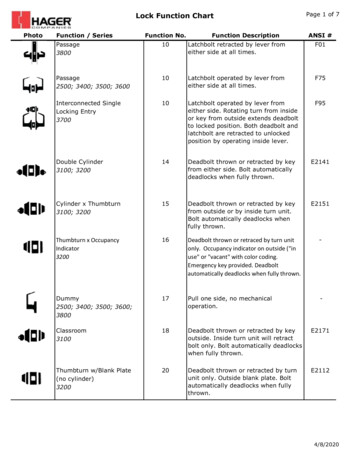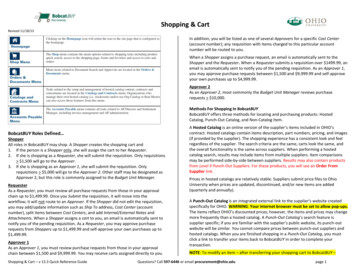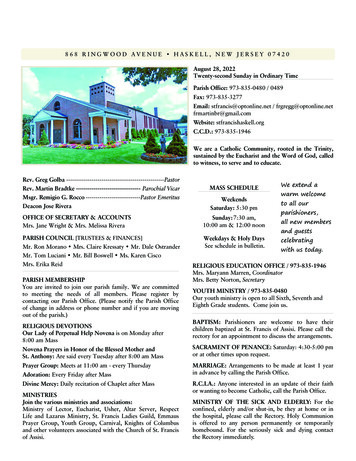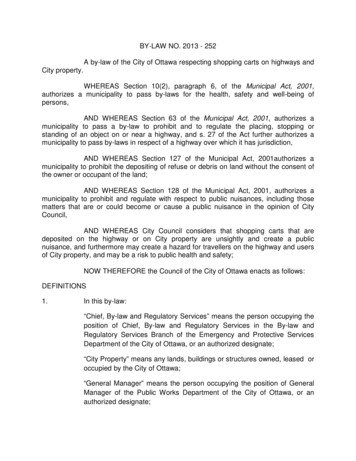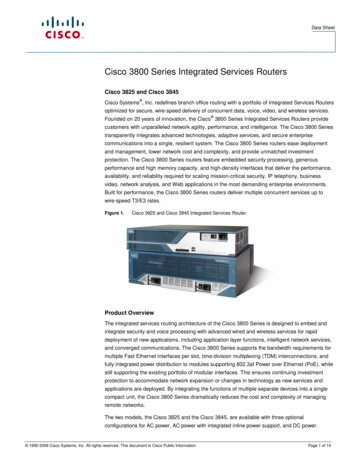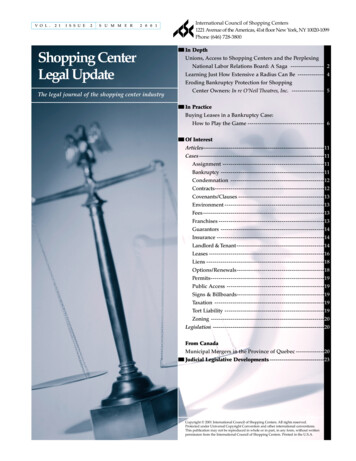
Transcription
V O L .2 1I S S U E2S U M M E R2 0 0 1Shopping CenterLegal UpdateThe legal journal of the shopping center industryInternational Council of Shopping Centers1221 Avenue of the Americas, 41st floor New York, NY 10020-1099Phone (646) 728-3800In DepthUnions, Access to Shopping Centers and the PerplexingNational Labor Relations Board: A Saga ------------------ 2Learning Just How Extensive a Radius Can Be ---------------4Eroding Bankruptcy Protection for ShoppingCenter Owners: In re O’Neil Theatres, Inc. ------------------5In PracticeBuying Leases in a Bankruptcy Case:How to Play the Game ---------------------------------------6Of ----------------------------11Cases --------------11Assignment 11Bankruptcy ---11Condemnation ---------------12Covenants/Clauses ronment -----------------13Franchises --13Guarantors ---14Insurance -----14Landlord & -14Leases ---------16Liens ----------------------------------19Public Access Signs & ---19Taxation ----19Tort Liability 9Zoning --------20Legislation -------20From CanadaMunicipal Mergers in the Province of Quebec --------------20Judicial Legislative Developments ----------------------------23Copyright 2001 International Council of Shopping Centers. All rights reserved.Protected under Universal Copyright Convention and other international conventions.This publication may not be reproduced in whole or in part, in any form, without writtenpermission from the International Council of Shopping Centers. Printed in the U.S.A.
on the shopping center property and ordered them to leave.The handbillers left. However, they returned the next day. Theshopping center’s manager again asked the union handbillersto leave and delivered a letter from its attorneys making thatsame request. Again, the union handbillers left. However, afew days later they returned and refused to leave at the security guard’s request. The shopping center manager called thelocal police. When the handbillers refused to obey policeorders, they were arrested for trespassing.Did that take care of the matter? No, not exactly. Theunion, after all, had rights. One of those rights was to file anunfair labor practice charge with the National Labor RelationsBoard (NLRB). The union alleged that the shopping centerhad violated Section 8(a)(1) of the Act, 29 U.S.C. Section158(a)(1). Consistent with its prior rulings on the access issue,the NLRB concluded that the shopping center had violatedthe National Labor Relations Act (NLRA ). The shopping center appealed and filed a petition for review with the U.S.Court of Appeals for the Sixth Circuit, which covers the statesof Ohio, Michigan, Kentucky and Tennessee. At the sametime, the National Labor Relations Board filed a cross application for enforcement.In DepthUnions, Access to Shopping Centersand the Perplexing National LaborRelations Board: A SagaMarty Denis*Barlow, Kobata & DenisChicago, IllinoisWhat can a shopping center do in the following circumstances? Consider a shopping center that contains 96 storesand a central concourse that provides access to the stores. Amall tenant starts construction. The mall tenant hires a nonunion construction contractor to renovate his stores. A localunion distributes handbills urging mall customers not topatronize the mall tenant. The union accuses the mall tenantof hiring a non-union contractor. The union contends that themall tenant has undermined local union wage standards.The handbill asks “the general public” not to patronize themall tenant “because they are undermining constructionwage and benefit status in this area by employing (a nonunion contractor).” The handbillers are not employees of theshopping center, the mall tenant or the non-union contractor.Previously, the shopping center has permitted organizationsseeking access to the mall to do so, provided they obtain permission and sign a temporary display permit. Permissionhas been granted to a variety of charitable, civic and evencommercial organizations where, in the shopping center’sbusiness operation, the activity enhanced the shopping center’s public image and provided service to the community.The NLRB’s RationaleWhat was the NLRB’s rationale for its decision? According tothe Board, the shopping center discriminatorily prohibitednon-employee union representatives from distributing handbills directly to shoppers in order to discourage them frompatronizing a non-union retailer at the shopping center. Thoseactions, according to the Board, were discriminatory becausethe shopping center had permitted non-labor-related handbilling and solicitations by others in the mall. Specifically, theshopping center had allowed such activities as an Easter Sealscake auction, a car inspection service, a gift-wrapping boothsponsored by the American Lung Association and anAmerican Red Cross Bloodmobile activity.The NLRB has long taken the position that handbilling byunions in this context is a protected activity under Section 7 ofthe Act. According to the Board, when excluding handbillingby union representatives, and permitting solicitation andhandbilling by various kinds of other organizations such asthe Girl Scouts, Knights of Columbus, political candidates oreven schoolchildren selling candy, a shopping center discriminates against the union. In earlier cases, the NLRB had heldthat the occasional presence of Muslims selling oils andincense, the occasional Jehovah’s Witness distributing theWatchtower magazine or an occasional local Lion’s Club solici-Denying Access to the Union HandbillersMust the shopping center permit the union’s handbilling? Ifthe shopping center does not permit the union’s handbilling,does that open up the shopping center to other legalheadaches?The shopping center in our example did not remain silentduring the handbilling. The shopping center notified theunion’s representative that any handbillers on mall propertywould be considered trespassers and would not be permittedto hand out handbills. The union ignored the shopping centerand continued to handbill inside the shopping center at themall tenant’s entrance. A shopping center security guard thentold the handbillers that they were not permitted to handbillShopping Center Legal Update is published by the Legal Department of the International Council of Shopping Centers, Inc., 1221 Avenue of the Americas, 41st floor,New York, New York, 10020-1099; John M. Ingram, Chairman; Michael P. Kercheval, President; Edward J. Sack, Staff Vice President and General Counsel.This publication is designed to provide accurate and authoritative information in regard to the subject matter covered. It is distributed with the understanding that thepublisher is not engaged in rendering legal, accounting, or other professional services. If legal advice or other expert assistance is required, the services of a competentprofessional should be sought.Editorial StaffEditor: Stephanie McEvily, Esq.Board: Stephen Christensen, Nelson, Rasmussen & Christensen, Salt Lake City, UT; William R. Crowe, Mayo, Gilligan & Zito, Wethersfield, CT; Marty Denis, Barlow,Kobata & Denis, Chicago, IL; Mark DePillis, Ballard, Spahr, Andrews & Ingersoll, L.L.P., Philadelphia, PA; Gary A. Goodman, Esq., Akin, Gump, Strauss, Hauer & Feld,L.L.P., New York, NY; Celeste Hammond, John Marshall Law School, Chicago, IL; David L. Huprich, Huprich & Krasnove, L.L.P., Cincinnati, OH; Murray F. Tait, T&TProperties, Sherwood Park, Alberta; Stephen W. Snively, Holland and Knight, Orlando, FL; Marilyn Sticklor, Goulston & Storrs, Boston, MA; John Cruz, Lewis, Rice &Fingersh, Kansas City, MO; Keith Wilson, Altman, Kritzer & Levick, P.C., Atlanta GA.2
center business may be negatively affected by one, yet notanother. For example, outside solicitors from people in anorganization who are sitting quietly at a table in a remote section of the shopping center would likely have a far differentimpact than if they were distributing handbills by roaming thecommon areas or picketing within the mall.tation can demonstrate discriminatory enforcement of a nosolicitation rule when the employer denies access to a union.Does this Board decision make sense? Well, this was exactly the situation posed in the case of Sandusky Mall Company v.National Labor Relations Board, (242 F. 3d 642 16th Cir., 2001), inOhio. The union handbilled. The handbilling was generallypeaceful. Entrance to the mall tenant was not blocked. Theshopping center owner asked the union representatives toleave. The representatives left. The representatives came back.They were again asked to leave. They refused. The police werecalled. An unfair labor practice charge was filed with theNLRB. The Board found that there was a violation and anappeal was taken to the Sixth Circuit. The critical question inSandusky was whether the courts should defer to the Board’sinterpretation. The Sixth Circuit said no. The Sixth Circuit didits own analysis of the judicial precedent and concluded thatthe Board’s view was not entitled to any deference and that itwas not legally sound.This isn’t the first time that the Sixth Circuit has rejectedthe Board’s interpretation of the NLRA. In an earlier decision,in Cleveland Real Estate Partners v. NLRB, 95 F.3d 457 (6th Cir.1996), the Sixth Circuit also rejected the Board’s contentionand held that there was no discrimination, at least in terms ofthe Board’s concept, when a shopping center owner excludedunion handbillers but allowed charitable-type distributions onthe mall property.No-Solicitation RulesAs a general matter, an employer, like a shopping center, mayproperly adopt no solicitation rules that are designed toexclude union handbillers on private property such as shopping malls. Those no-solicitation rules must, of course, beapplied in a non-discriminatory manner. The question of whatis “discrimination” has perplexed the courts for many years.The Board has not been so perplexed. The Board has taken theposition that permitting non-union organizations to solicitconstitutes discrimination under the Act and should not beallowed. According to the Board, the solicitation by variousother organizations is sufficient proof of disparate treatmentor discrimination.The Sandusky decision reaffirms the earlier Cleveland RealEstate Partners decision that the focus of discriminatory conduct in allowing solicitation by other handbillers requires thatthe discrimination be among comparable groups or activitiesand that the activities themselves under consideration must becomparable. What does that mean? It means, in effect, that thefocus is on whether or not union handbillers have previouslybeen allowed access. If so, to preclude a subsequent handbillerwho happens to be union from handbilling would constitutediscrimination. This, of course, is a narrow reading of theNLRA and one to which the Board does not subscribe. Thefocus of the Sixth Circuit’s view is on the nature of the conduct for which access is sought and the effect, if any, this typeof conduct reasonably could be expected to have. The underlying predicate is that employers, including shopping centerowners, must be able to make distinctions based on time,place and means of solicitation to the extent that shopping* Marty Denis is a partner in the firm’s Chicago office.3Shopping Center Legal Update Vol. 21 Issue 2Particularly where area standards picketing or handbilling isat issue, the courts have given less deference to the Board’sinterpretation of the Act. Non-employee area standards picketing or handbilling generally warrants less protection thanemployee organizational activities under Section 7 of the Act.This is so because the right to handbill about non-employeearea standards wage issues is considered a more peripheralright under the Act. Note, too, that the Sandusky case does notinvolve organizational rights. It does not involve employeepicketing or handbilling. Furthermore, there was nothing inSandusky to indicate that the shopping center owner hadencouraged or allowed handbilling by persons similarly situated to the union organizers. Any of those latter facts mightrequire a different result. This is because there is a spectrum ofrights that attach to union handbilling and union picketing.Each must be analyzed in its own context.The bottom line, at least in the Sixth Circuit, is that unionhandbilling that involves area standards issues can be barredfrom a shopping center’s property as long as the shoppingcenter maintains non-discriminatory rules and applies thoserules on a non-discriminatory basis vis-à-vis other unionhandbilling and picketing. Remember, too, that the SixthCircuit only covers Ohio, Michigan, Kentucky and Tennessee.Other circuits, some of which may be more liberal—for example, the Third Circuit in Philadelphia or even the EleventhCircuit in Atlanta—may take a different approach. The Board,too, may at some point decide to seek review by the SupremeCourt to overturn the Sixth Circuit’s approach. Whether theBoard will do that in the current judicial climate of theSupreme Court is problematic.The bottom line for shopping centers and their tenants isthis: With non-employee union handbillers who are deniedaccess to a shopping center, the NLRB will likely find a violation if the no-solicitation rule is applied in a discriminatorymanner vis-à-vis charitable organizations. The Board is notlikely to change its views. The Board’s orders are, however,not self-enforcing. The federal courts of appeals, which canenforce the Board’s orders, have generally been reluctant toenforce the Board’s orders in this context. Double check thelaw in your particular location—i.e., the particular law of thefederal Court of Appeals—before you exclude union handbillers. The law will likely remain unsettled. This tusslebetween the NLRB and the courts of appeals will continueuntil the Supreme Court resolves the issue.In the interim, the safest, most conservative approach forshopping centers and their tenants is to consistently enforcetheir no-solicitation rules.Summer 2001Less Protection to Union Area Standards Activities
deed, Donuts-R-Us would have to show evidence of lostprofits and provide some way of determining the value ofthese lost profits with some degree of certainty. Although itdid not rule on the issue of damages, the court did find thatit was possible for Donuts-R-Us to show evidence of the difference between the value of the leasehold with the restrictive covenant unbroken and the value of the leasehold withthe restrictive covenant broken.The court’s holding (if the restriction in the lease betweenDonuts-R-Us and the Mabroses had been included in thedeed, then Wal-Mart would be in clear violation of thecovenant) is consistent with that set forth in Renee Cleaners,Inc. v. Good Deal Super Markets of N.J., Inc., 214 A. 2d 437 (N.J.Sper.Ct. 1965), where the court reasoned that a landlord’sradius promise was implicit. Here, the landlord’s promisewas explicit.The Mabros court’s finding may seem to be a stretch.(Even though the bakery was not located on the land purchased from the Mabroses, because the resulting bakedgoods were displayed throughout the store and a portion ofthe store was located on the land purchased from theMabroses, the radius restriction was violated.) However,such a stretch was far less than that of the Third Circuit inJ.C. Penney Company, Inc. v. Giant Eagle, Inc., 85 F. 3d 120 (3rdCir. 1996), where the court basically brought a restrictionback from the dead to protect a tenant. In this case, in 1962, adrugstore tenant’s 30-year lease contained an exclusive useclause. In 1977, the landlord entered into a lease with a grocery tenant. Although the drugstore tenant recorded a memorandum of its lease, the memorandum did not mention theexclusive use clause. In 1978, the landlord and the drugstoretenant (now under new management) renegotiated the drugstore tenant’s lease, replacing the 1962 lease with a new lease(which did not contain an exclusive use clause) and relocating the store’s location. Shortly before the scheduled expiration of the replaced 1962 lease, the grocery tenant decided toestablish a drugstore within its grocery store. The drugstoretenant argued that the 1962 exclusive use clause implicitlybecame part of its 1978 lease and, amazingly, the ThirdCircuit agreed.What is particularly interesting about Mabros is not itsholding, but its implications for after-acquired propertyclauses. Unless it pays close attention to each and every clausein all of the leases of space covering portions of the property itacquires, a purchaser can find itself tripped up in a most unexpected way, not only with respect to its current use of thatproperty, but also with possible future uses. The volume ofpurchases and sales that have taken place over the past several years makes this “tripping over our own shoelaces” agreater risk than in the past. So many shopping centers arenow held by real estate investment trusts. If there should be asubstantial consolidation in the retail segment of the REITindustry, where one retail REIT is taken over by another REIT,and insufficient due diligence is done during these otherwisecorporate and securities transactions, we could find that therewill be a “whole lot of tripping going on.”Learning Just How Extensive aRadius Can BeGary A. Goodman*Akin, Gump, Strauss, Hauer & Feld, L.L.P.New York, New YorkPrized retail tenants often find themselves the subject oflandlords’ radius restrictions so that when they find one ofthese restrictions working in their favor, they hold onto it fordear life. A recent case, Mabros v. Donuts-R-Us, Inc., 536 S.E.2d 215 (Ga. App. 2000), illustrates the problem with such aclause when there is after-acquired property, especially whenthe new landlord is a transferee of the landlord that negotiated and signed the lease containing the radius restriction.On May 11, 1992, Donuts-R-Us leased a building andland from Bill and Milly Mabros. Section Eight of the leaseprovided that, during the term of the Donuts-R-Us lease, orany extension of that lease, the Mabroses would not lease oruse any land they owned or controlled within a one-mileradius of Donuts-R-Us’s premises for the manufacturing orwholesale or retail sale of donuts, pies, pastries or bakeryproducts. An exception to this restriction was to be made ifsuch baked goods were not manufactured on the premisesand were sold in connection with the operation of a supermarket, convenience store, restaurant, diner, luncheonette orsoda fountain. This restriction was to be included in allleases or sales contracts of any land that the Mabrosesowned or controlled within such one-mile radius.A few years later, the Mabroses sold land to Wal-Martthat was located within one mile of Donuts-R-Us. The aboverestriction was not included in this deed, and Wal-Mart subsequently opened an in-house bakery. Accordingly, DonutsR-Us brought suit against the Mabroses on a breach ofcontract claim and move for summary judgment. The trialcourt granted summary judgment, and the Mabrosesappealed. The Court of Appeals of Georgia affirmed the trialcourt’s grant of summary judgment to Donuts-R-Us forbreach of contract, because the Mabroses failed to includethe radius restriction in the deed to Wal-Mart.Although the bakery was located inside of the Wal-Martstore, it was actually located on a section of Wal-Mart’s property that was not purchased from the Mabroses. However,the court of appeals found that, even though the location ofthe manufacturing of the baked goods was not on land purchased from the Mabroses, such baked goods were displayedthroughout the store, including that portion which waslocated on the land previously owned by the Mabroses.Therefore, the court held that, if the restriction in the leasebetween Donuts-R-Us and the Mabroses had been includedin the deed, Wal-Mart would be in clear violation of thecovenant.Additionally, the court held that the Mabroses did not, asa matter of law, establish that Donuts-R-Us could not showdiminution in the value of the leasehold estate. The courtruled that in order for it to determine the damages resultingfrom the Mabroses’ failure to include the covenant in the*Gary A. Goodman is a partner in the firm’s New York office.4
that O’Neil had left all its property in the space, a possibilityexisted that O’Neil would seek to assume the lease in bankruptcy. Prior to rejection, Market Street could not sign a newtenant to the premises and was further limited in its ability tomarket the space in good faith because it could not predict theultimate disposition of the property.Three days after the bankruptcy filing, O’Neil filed amotion under 11 U.S.C. §365(a) to reject the Market Streetlease. O’Neil’s motion was heard on September 8, 2000. Thecourt rejected the lease, but reserved ruling on the date uponwhich the rejection was effective. The court contemplated fourpotential dates for the rejection of the lease:Eroding Bankruptcy Protection forShopping Center Owners: In reO’Neil Theatres, Inc.David B. Kurzweil, Esq.,* and David M. Pernini,† Esq.Kritzer & Levick, P.C.Atlanta, GeorgiaShopping center owners (“landlords”) are placed in a uniqueand precarious position when one of their tenants seeks protection under the Bankruptcy Code. A tenant’s bankruptcyforces the landlord into the unfortunate role of a compelledcreditor who is required by law to continue to provide servicesto the debtor. The landlord has no real assurance of paymentor knowledge of how its space will ultimately be used, yet isprevented by law from evicting, or even threatening to evict, abankrupt tenant. To level the playing field, the shopping center industry lobbied successfully for certain protections in the1984 amendments to the Bankruptcy Code, commonlyreferred to as the “Shopping Center Amendments.” Accordingto these amendments, a debtor has 60 days (unless extendedby the bankruptcy court for cause) to assume or reject a lease.Further, the trustee is required to timely perform all of its obligations under the lease, including payment of rent, until thelease is assumed or rejected. These provisions, in theory atleast, provide some measure of protection against a debtor’sindecision or inadvertence. In practice, the amendments haveproven less effective than originally intended because thecourts have slowly eroded the protections intended by theamendments. Courts routinely extend the 60-day limit, making it more the exception than the rule, thus continuing theuncertainty that the Shopping Center Amendments wereintended to address.1A recent decision from the Bankruptcy Court for theEastern District of Louisiana, In re O’Neil Theatres, Inc., 257 B.R.806 (Bankr. E. D. La. 2000), threatens to erode these protectionsfurther. In O’Neil, the court retroactively approved the rejection of a lease to the date of the bankruptcy filing, thus denying the landlord’s administrative claim for payment of rent.This ruling, if expanded beyond the specific facts of O’Neil,could cause a significant financial burden on commerciallandlords.August 11, 2000August 25, 2000August 28, 2000September 8, 2000the date O’Neil vacated the propertythe date O’Neil filed for bankruptcythe date O’Neil filed its motion toreject the leasethe date the court rejected the leaseInitially, O’Neil argued that the lease should be rejectedretroactive to August 11, 2000. Later, O’Neil changed its position and argued that the rejection should be effective no laterthan August 28, 2000, the day it filed its motion. Market Streetargued that the rejection should not be applied retroactively atall, but should be effective as of the date of the court’s ruling:September 8, 2000.The court, rejecting what it described as the “majorityview,” held that O’Neil’s affirmative act of closing its theatreon August 11 and Market Street’s act of padlocking the premises the next day indicated that both parties had rejected thelease on that date. However, because those actions predatedthe bankruptcy filing, the equities and circumstances dictatedusing the petition date as the date for rejection, even though itwas three days prior to the date O’Neil filed its motion to reject.The DecisionIn February 1993, O’Neil Theatres (“O’Neil”) entered into anagreement with Market Street Developers, Ltd. (“MarketStreet”), to lease space in the West End Market Place ShoppingCenter in Dallas, Texas. In early 2000, O’Neil had experiencedoperating losses and attempted to negotiate a reduction inrent with Market Street. Those efforts proved unsuccessfuland, on August 11, 2000, O’Neil voluntarily closed the theatreand vacated the space, leaving everything except the movies ithad leased from third parties. The next day, Market Streetpadlocked the premises, excluding O’Neil from entry. OnAugust 25, 2000, O’Neil filed a voluntary petition for bankruptcy relief under Chapter 11.At this point, O’Neil had not given any indication of itsintention to assume or reject the lease in bankruptcy. Given5Shopping Center Legal Update Vol. 21 Issue 2The court in O’Neil did not cite any existing precedent forretroactively rejecting a lease before a motion to reject is filed.Instead, the court relied upon dicta from a decision of the FirstCircuit addressing the retroactive application of a motion toreject a lease, In re Thinking Machines Corp., 67 F.3d 1021 (1stCir. 1995), and a similar, but distinguishable, decision from theBankruptcy Court for the Northern District of Texas, In reAmber’s Stores, Inc., 193 B.R. 819 (Bankr. N.D. Tex. 1996).In Thinking Machines, the First Circuit reversed a districtcourt decision that retroactively rejected a commercial lease.After performing a textual and historical analysis of 11 U.S.C.§365, the First Circuit concluded that the legislative history ofthe section and the structure of the Bankruptcy Code compelthe conclusion that the rejection of a lease should not beapplied retroactively. The First Circuit stated that to hold otherwise would “trivialize judicial oversight of the rejectionprocess (set out in 11 U.S.C. §365).” 67 F.3d at 1028. The FirstCircuit noted, however, that because bankruptcy courts arecourts of equity, a court could, when equity dictates, approvea rejection of a lease retroactive to the “motion filing date.” Inre Thinking Machines Corp., 67 F.3d at 1021, 1024 (1st Cir. 1995).In Amber’s Stores, the debtor vacated the leased premisesover a month before filing bankruptcy and filed a motion toSummer 2001The Court’s Rationale: An Extension ofExisting Law?
reject the lease simultaneously with its petition for relief underChapter 11. In considering the debtor’s motion, the court discussed at length the appropriateness of the majority rule thatlease rejections should not be effective until ordered by thecourt. However, the court ultimately applied equitable principals and held that, because Amber’s Stores had turned overthe keys, vacated the premises prepetition and served amotion to reject the lease as soon as possible, retroactive rejection of the lease as of the date of the motion was warranted.193 B.R. at 825-827.Neither Thinking Machines nor Amber’s Stores addressesthe possibility of deeming a lease rejection effective retroactiveto a date prior to the filing of a motion to reject. Nevertheless,the court in O’Neil used both these decisions as springboardsfor its expansion of this limited exception to the majority rule.The court in O’Neil rejects any distinction between a formalnotice of rejection of a lease in the bankruptcy context (asoccurred in Thinking Machines) and constructive notice of anintent to reject a lease prior to a bankruptcy filing based on theprepetition behavior of the debtor. 257 B.R. at 807. In a similarmanner, the court in O’Neil accurately states that the court inAmber’s Stores retroactively rejected the lease as of the petitiondate, but does not address the fact that the petition date coincided with the filing of a motion to reject the lease. 257 B.R. at807-808. The court in O’Neil does not explain why it chose thepetition date over the date the debtor filed the motion to rejectthe lease. It based its decision on the prepetition conduct ofthe parties despite the fact that the prepetition conduct of theparties is not a consideration enumerated in 11 U.S.C.§365(d)(3) or (4).rejection of a lease does not become effective until after thecourt approves a motion to reject. As courts following themajority rule have noted, allowing retroactive rejection of leases would frustrate the goals of the Bankruptcy Code because: it is inconsistent with the legislative history of 11 U.S.C.§365; it trivializes the role of the court to merely approving theactions of the debtor or trustee (Thinking Machines, 67 F.3d.at 1026); it prevents the landlord from having notice and an opportunity to be heard before its rights are adjudicated; [In reWorth Stores, Inc., 130 B.R. 531, 534 (Bankr. E.D. Mo. 1991)];and i
158(a)(1). Consistent with its prior rulings on the access issue, the NLRB concluded that the shopping center had violated the National Labor Relations Act (NLRA ). The shopping cen-ter appealed and filed a petition for review with the U.S. Court of Appeals for the Sixth Circuit, which covers the states of Ohio, Michigan, Kentucky and Tennessee.
